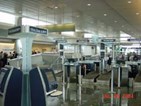Self-Service: A Better Way For Airport Check-In

Alaska Airlines has doubled the number of passengers it gets through its airport lobbies in the same amount of time the manual check-in process took. The unique self-service process allows passengers to check in and drop off luggage by themselves.
In 1998, the airline formed an "Airport of the Future" team with employees all from throughout the company, including representatives from the facilities, IT, marketing, in-flight departments. Seeking input on how to create a better way of getting customers through the check-in process, the initial meeting was an outstanding success, says Jeff Anderson, Alaska Airlines' director of airport technology.
with employees all from throughout the company, including representatives from the facilities, IT, marketing, in-flight departments. Seeking input on how to create a better way of getting customers through the check-in process, the initial meeting was an outstanding success, says Jeff Anderson, Alaska Airlines' director of airport technology.
The airline's chief executive at the time made it clear that he wanted to take advantage of the growing use of electronic ticketing and self-service kiosks, Anderson says.
"He did not want to see a traditional ticket counter," Anderson said.
The team went to work in a special warehouse, where over the course of the next several years mock counters, kiosks and bagging areas were moved around and shuffled all in an attempt to find an appropriate check-in configuration.
In 2003, the airline discovered the "two-step flow-through," its signature check-in process. That procedure was later awarded a U.S. patent.
The process works as such: Passengers enter the lobby and approach a bank of kiosks. From there, passengers go either left or right, depending on where the baggage belts are located, and they drop their luggage off.
For those who take longer at check-in, the kiosk might direct them to a ticket counter, which is located behind the kiosks, to speak with a customer agent. For instance, Anderson says, a group of people who are traveling together or an unaccompanied minor or even someone traveling with a pet might be sent to the counter.
"The kiosk sorts the passengers for us," he said. "That  sorting, between transactions that are short and those that take more time, is really what helps us get more customers through our kiosk and baggage locations."
sorting, between transactions that are short and those that take more time, is really what helps us get more customers through our kiosk and baggage locations."
Alaska Airlines' Web-site check-in also tells customers whether they should proceed to the baggage area or to the ticket-service counter.
The Ted Stevens Anchorage International Airport in 2004 was the first to adopt the check-in process. The Anchorage airport has 25 check-in kiosks. The average transaction at the kiosk and the bagging-stop is two minutes, a significant decrease from when the airline performed face-to-face passenger transactions, Anderson says.
But some airports, particularly older ones, don't have room to accommodate a check-in process like Alaska Air's.
To bypass that barrier, the airline has come up with some alternatives, including mounting kiosks on ticket counters or putting two kiosks on one podium with a baggage belt on either side.
According to Alaska Air, at the mounted kiosks average 21 passengers an hour per agent. And the two-kiosks-on-one-podium approach averages 31 passengers an hour per agent.
And the default "two-step flow-through" process yields an average of 42 passengers per hour.
Alaska Air also just announced phase one of a three-phase rollout of a check-in system at the Seattle-Tacoma International Airport. The system's layout is expected to be a modified version of what is used in Anchorage.
"It expands our terminal without building anything," said Perry Cooper, a spokesman for the Seattle-Tacoma International Airport.
The process also is expected to be introduced at other airports in Portland, Ore., and Las Cabos, Mexico. A modified version is already available at 15 airports in Alaska, Los Angeles and Boise, Idaho.
Alaska Air, which owns the rights to the "two-step flow-through" system, says it has been contacted by other airlines interested in deploying something similar. Some of the airlines have already copied the method, Anderson says.
"We are OK with that," he said. "It is not our intent to limit someone's ability to use an efficient model for checking in customers."
SOURCE: Alaska Airlines
